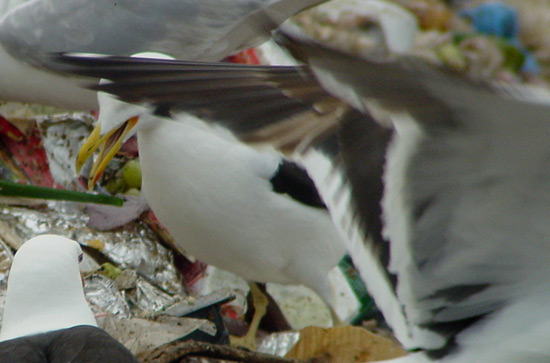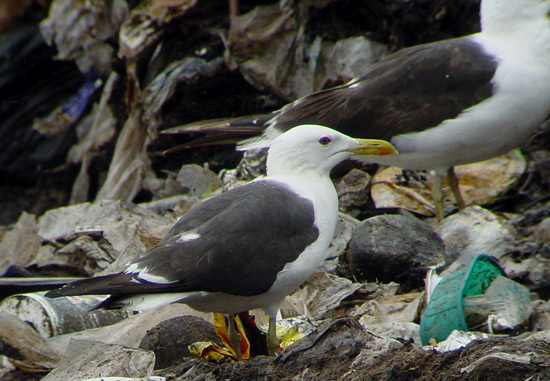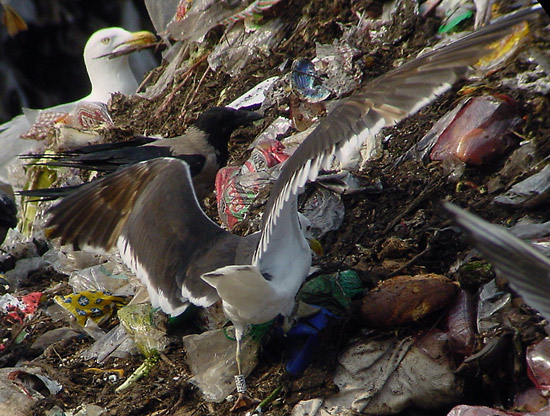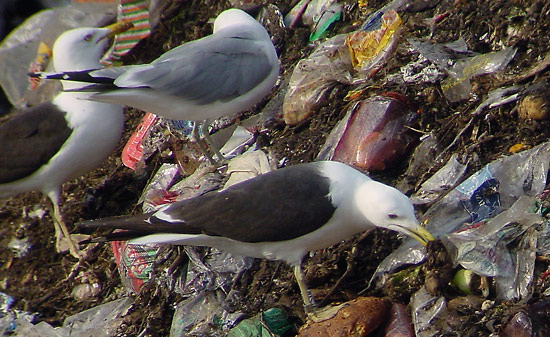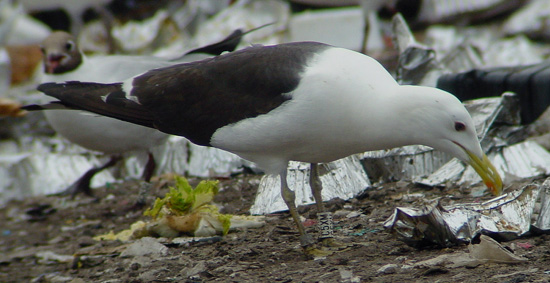
(5 images) Larus fuscus fuscus 3cy C5XM, July 10-16 2003, Tampere, Finland (61.33N 24.59E).
C5XM was ringed in Hauho, Finland;
ringed as pullus on June 30 2001 by Risto Juvaste.
Recorded
at Tampere:
2003-05-18,
2003-05-21,
2003-05-24, 2003-05-31, 2003-06-03, 2003-06-14, 2003-06-17, 2003-06-18,
2003-06-20, 2003-06-22, 2003-06-28, 2003-07-05, 2003-07-06, 2003-07-10,
2003-07-11, 2003-07-12, 2003-07-14, 2003-07-15, 2003-07-16, 2003-07-23,
2003-07-24.
Larus fuscus fuscus in 2cy often returns
with completely replaced primaries and secondaries. In 3cy, fuscus more
often shows a clear division between fresh inner primaries and older outer
primaries, the inner primaries often showing neat white tips and the outer
primaries often second generation-like with rounded tips and paler bleached
brown. The arrested moult in the primaries is often reflected in the secondaries
and (to a less extend) in the tail-feathers as well. The older tail-feathers
(often R5 is older) still show a broad dark sub-terminal band.
3cy fuscus often have some black markings on the bill, which is otherwise
much adult-like, with a clear red gonydeal spot. The colour of the naked parts
are adult-like as well.
The scapulars in 3cy are often completely adult-like, lacking internal patterns;
plain blackish grey with a mahogany hue on the older feathers. Most wing-coverts
and tertials are adult-like blackish grey as well, but often 3cy birds show some
very bleached pale brown wing-coverts, normally in the greater covert bar and in
the upper rows of the lesser coverts. These bleached wing-coverts accentuate the
jumpy sequence in the last wing-covert moult cycles, as there is often no clear
pattern in location of these bleached feathers. Head and body feathers normally
are snow-white by July.
C5XM was ringed in Finland, now in 3cy. This 3cy fuscus
has an aberrant moult cycle in the primaries, as can be seen in the image of the
left wing:
P1-P2 are old and bleached primaries, P3-P5 are fresher, probably 3rd generation, P6-P8
are old again
and P9-P10 fresh primaries with a mirror on P10. The exact moult sequence is hard to predict, more so since the inner
primaries (P1-P2) are paler and probably older than P6-P8. Nonetheless it seems
reasonable to conclude that the two outer primaries P9-P10 were moulted on the
wintering grounds, about half a year ago. This may explain the relatively large
mirror on P10. For unknown reason, the innermost primaries were excluded from
the subsequent moult, which continued at P3 and was arrested at P5. P5 has a
clear sub-terminal black band and a white tip, as can be found commonly in 3rd
generation P5.
Moult in the secondaries followed an irregular sequence as well, with the outermost secondary (S1)
replaced long ago, probably still 2nd generation. S2-S3 are obvious fresher,
probably 3rd generation with a grey base and neat, large white tip. Again, S4
may be 2nd generation and S5 3rd generation. This jumpy sequence seem to
continue in the inner half of the secondaries. Most rectrices appear fresh with pretty neat tips and
are white without
any black markings, but R5 (on both sides) show a clear broad sub-terminal band,
commonly found in early required 3rd generation rectrices. Note the dark
speckling in the iris.
In the third image, two 3cy fuscus, both with arrested moult in the outer primaries.

